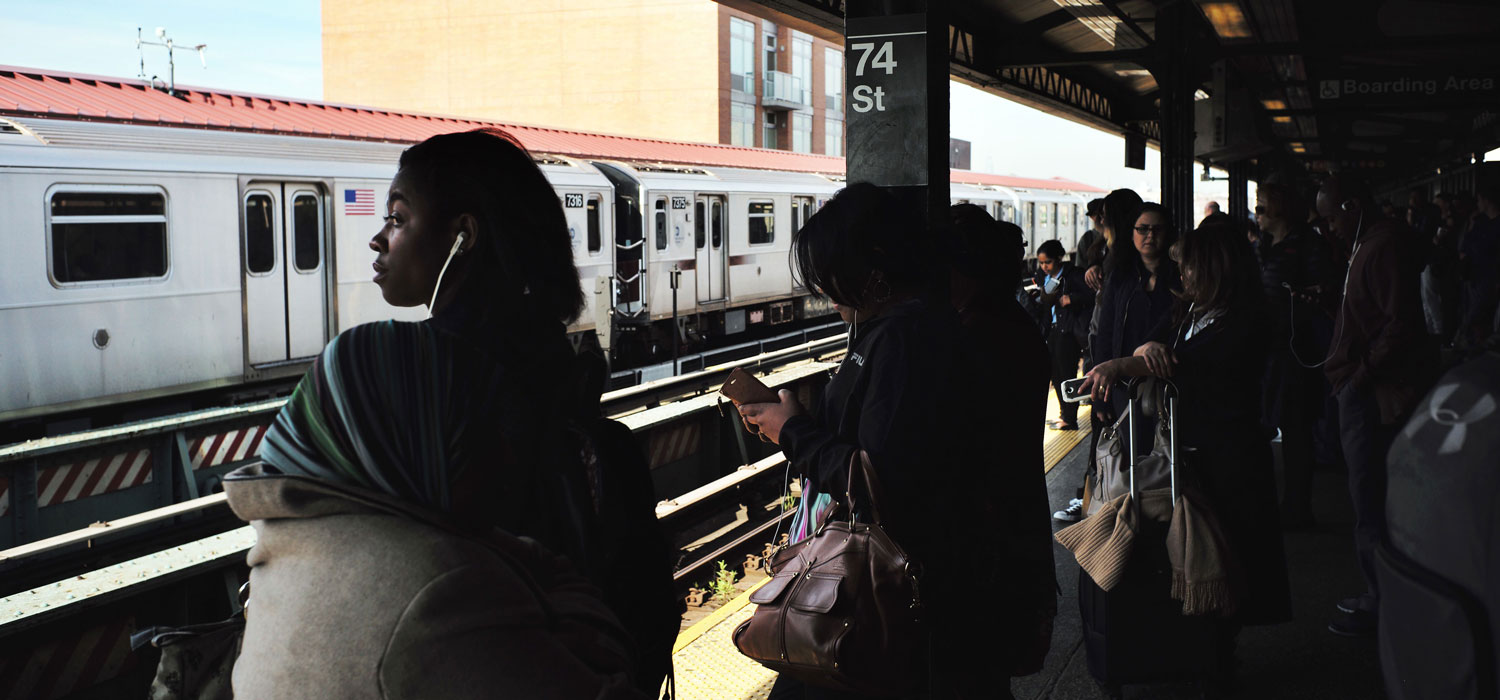
<p>Morning commuters wait for their trains at a train station in New York on May 11, 2016. Photo by Jewel Samad/AFP/Getty Images</p>
Much has been made over the last few years about new trends in transportation. Americans—particularly millennials—are buying fewer cars, driving less, and turning to public or alternative transit more. A boom in transportation options, investment in transit in dense urban areas, and a growing sensitivity to the impact of cars on the environment has allowed some people to make fewer car trips and own fewer vehicles.
Yet, the households with the most to gain from expanded transportation options are also the ones most likely to be excluded from them. Whether it is car ownership, new forms of ride sharing, or traditional transit, low-income families may struggle to pay for reliable transportation, may be missing out on new options, and may have fewer fallbacks when their transportation falls through.
Despite the popular narrative, nearly 90 percent of American households own at least one vehicle. It seems obvious that in rural areas cars are a necessity, but in cities and suburbs, days often start and end with car trips between home and transit hubs, jobs, child care, schools, after-school activities, and errands. With some intriguing exceptions, avoiding car ownership in favor of public, shared, or alternative transportation seems to be an option mainly for young people in prime urban neighborhoods. For most American families, a privately owned car remains the most reliable and convenient transportation option.
This is just as true—if not more so—for low-income families as it is for wealthier households. Jobs and high-quality schools tend to be located outside low-income neighborhoods, and affordable, opportunity-rich neighborhoods may be in low-density suburbs with limited public transit. It should be no surprise that car access has been found to have important, positive impacts on low-income families’ income and well-being.
But car access isn’t always easy to come by. In 2015, AAA estimated that on average, owning a modest car cost close to $9,000 annually, while average annual income for a household living in federally assisted housing was roughly $14,000. Affordable, reliable alternatives to car ownership such as ride sharing are expanding, but low-income families are not adopting them as quickly as higher-income households. A recent Pew report found that nearly half of low-income families were unfamiliar with ride-sharing options (compared with just 14 percent of higher-income households).
For families of any income, a lack of reliable transportation may mean missing work, arriving late, or missing school. But for low-income families, it could mean missed job opportunities or forgoing opportunity-rich neighborhoods or high-quality schools because they are nearly impossible to reach without access to a privately owned vehicle.
With this in mind, how can cities ensure that the lowest-income households and neighborhoods benefit from new transportation innovation?
In a recent essay, Rolf Pendall and colleagues explore this question and propose new regional coalitions focused on assessing local needs and pursuing equitable transportation systems. A first step for these coalitions may be to research the barriers preventing low-income families from taking advantage of on-demand and shared transit. Smartphone data plans may be prohibitively expensive; families who don’t have bank accounts may need alternative payment options and help connecting to formal banking to connect to new opportunities. Or, communities may need to be made aware of new options and how to access them. Once armed with more knowledge about how to make new technologies work for poorer communities, coalitions can recommend effective strategies to overcome barriers.
The private sector could be a key partner in this effort. Large employers are experimenting with new, sometimes controversial, modes of transportation for their employees: Ford is piloting on-demand rides around its Dearborn, Michigan, offices; Microsoft offers free bus and shuttle services for Seattle employees; and Google’s buses for San Francisco employees recently became permanent. There has been backlash against Microsoft and Google, in particular, for these efforts—which some view as symbolic of gentrification and displacement. By bringing employers to the table in a larger conversation about transportation equity, cities can encourage employers to extend these new transit services to vulnerable workers and neighborhoods disconnected from job and education centers.
Shared transportation models have taken hold. What we need now are mechanisms to ensure the expansion includes communities who stand to benefit most.
This post is part of a series funded by the Rockefeller Foundation that explores how city leaders can promote local economies that are inclusive of all their residents. The framing brief, “Open Cities: From Economic Exclusion to Urban Inclusion,” defines economic exclusion and discusses city-level trends across high-income countries. The four “What if?” essays suggest bold and innovative solutions, and they are intended to spark debate on how cities might harness new technologies, rising momentum, and new approaches to governance in order to overcome economic exclusion.
Let’s build a future where everyone, everywhere has the opportunity and power to thrive
Urban is more determined than ever to partner with changemakers to unlock opportunities that give people across the country a fair shot at reaching their fullest potential. Invest in Urban to power this type of work.